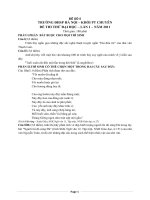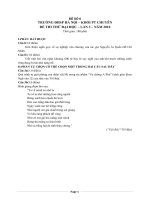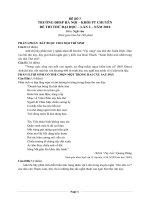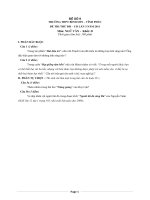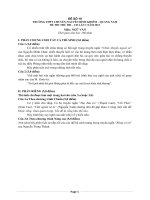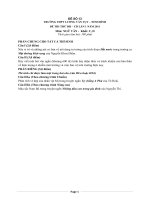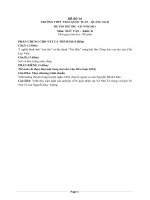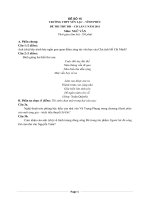đề thi thử tiếng anh đại học các trường THPT chuyên trên toàn quốc đề số (19)
Bạn đang xem bản rút gọn của tài liệu. Xem và tải ngay bản đầy đủ của tài liệu tại đây (265.4 KB, 7 trang )
Page 1
ĐỀ SỐ 2
Đề thi thử đại học lần VI (2013) – Trường chuyên Đại học SPHN
Mã đề số: 461
Thời gian làm bài: 90 phút
ĐỀ THI GỒM 80 CÂU (TỪ CÂU HỎI SỐ 1 ĐẾN CÂU HỎI SỐ 80) DÀNH CHO TẤT CẢ CÁC THÍ
SINH
Mark the letter A, B, C, or D on your answer sheet to indicate the word whose stress is placed differently
from that of the others in each of the following questions.
Question 1. A. applicant B. commitment C. substantial D. domestic
Question 2. A. certificate B. necessary C. advertisement D. technology
Question 3. A. bamboo B. diverse C. throughout D. contact
Question 4. A. philosopher B. initiate C. enthusiast D. kindergarten
Question 5. A. deep-seated B. childbearing C. determine D. eternal
Mark the letter A, B, C, or D on your answer sheet to indicate the correct answer to complete each of the
following questions or the answer that is closest in meaning to the underlined part.
Question 6. Although the government has taken certain measures to elephants, numerous threats remain for
them.
A. to much B. a lot of C. some D. a few
Question 7. getting a new camera. This one is getting really old now.
A. I’m thinking of B. think of
C. I think about D. I have thought of
Question 8. When I was younger. I romantic stories, but now I love them.
A. didn’t use to like B. wasn’t liking
C. wouldn’t like D. wasn’t use to like
Question 9. A : Do you mind if I open the window a little?
B: .
A. probably, but then they ̉ll start to blow again.
B. No, they ̉ll dry better by the radiator.
C. Only if I have to stand up in them for a long time.
D. The problem is, the candles might blow out in the draught.
Question 10. Let’s think about this puzzle again – there an obvious answer.
A. has to have been B. has to be C. must have been D. has
Question 11. Sam’s not in – he’s to be at the gym as usual.
A. probable B. bound C. possible D. sure
Question 12. Simpson Footballer of the Year on two different occasions.
A. was declared as B. was voted
C. was named by D. was regarded
Question 13. change to the programme must be approved by the committee.
A. any B. some C. several D. many
Question 14. A: Our front room gets very warm.
B: .
A. Doesn’t B. Mine haven’t
C. Mine does, either D. So does mine
Question 15. In synchronized swimming, the players perfrom beautiful maneuvers to music and driving.
A. swimming suits C. scuba sets
B. tools for swimming D. movements that need skill and care
Question 16. sure to be lots of people trying to buy tickets, so make sure you get there early.
A. It’s B. They’re C. There are D. There is
Question 17. I ̉m exhausted - football all morning.
A. I ̉ve been playing B. I ̉m playing C. I ̉ve played D. I played
2
Question 18. She denied who had stolen the money.
A. that she knew B. her knowing C. to know D. she knowing
Question 19. The ASEAN Para-Games are hosted by the name country where the SEA Games took place.
A. organized B. impressed C. participated D. defended
Question 20. They ̉re looking for someone who has of working with disabled people.
A. experiences B. an experience
C. experience D. much experiences
Question 21. A: You don ̉t look very well.
B: .
A. How rude!
B. Again? What terrible weather we ̉ve had this summer!
C. Oh no. That ̉s such a shame.
D. Yes, I didn ̉t sleep last night. I ̉m so tired.
Question 22. The agenda for the end-of-term meeting too long.
A. are B. is C. were D. was being
Question 23. It came as a to my parent when I told them I wanted to leave school.
A. nightmare B. shock C. horror D. right
Question 24. Books are a primary means for dissemination of knowledge and information.
A. attempt B. distribution C. invention D. variety
Question 25. The project was very successful and we would like to thank everyone.
A. particular B. concerned C. invention D. variety
Question 26. During the months, the emperors and their families used to move away from the city.
A. winters B. winter’s C. winter D. winters’
Question 27. The amount of electricity used by Science City is high as in many other universities.
A. nothing like B. nothing as C. nothing like as D. no as
Question 28. It ̉ll be a long time before people live on the moon, but I ̉m sure it ̉ll happen .
A. occasionally B. apparently C. eventually D. often
Question 29. In my opinion, the idea of living to 1,000 terrible.
A. appears B. sounds C. goes D. gets
Question 30. A: My uncle bought me a new bike.
B: .
A. What a relief! C. Amazing! We had such fun.
B. How exciting! D. What a nice guy?
Question 31. A: I’m sorry you have to leave so soon.
B:
A. So are we. B. So do I. C. Aren ̉t you? D. Not have I.
Question 32. If only you the receipt, we would have been able to help you.
A. kept B. had kept C. would have kept D. was keeping
Question 33. Next weekend I’m going to Caracas, I used to live.
A. that B. which C. where D. when
Question 34. we enjoy the film, we both found this one a bit long and boring.
A. If B. Despite C. Much as D. As
Question 35. We all seem to have a different opinion, so let ̉s Joey decide, ?
A. do we B. shall we C. will we D. don ̉t we
Read the following passage and mark the letter A, B, C, or D on your answer sheet to indicate the correct
answer to each of the question from 36 to 45.
Line
Carbon dating can be used to estimate the age of any organic natural
material; it has been used successfully in archeology to determine the age
of ancient artifacts or fossils as well as in a variety of other fields, the
principle underlying the use of carbon dating is that carbon is a part of
Page 3
5
10
15
all living things on Earth. Since a radioactive substance as carbon - 14 has
a known half-life the amount of carbon-14 remaining in an object can be
used to date that object.
Carbon - 14 has a half - life of 5,570 years, which means that after that
number of years half of the carbon-14 atoms have decayed into nitrogen-
14. It is the ratio of carbon-14 to nitrogen-14 in that substance that
indicates the age of the substance. If, for example, in a particular sample
the amount of carbon-14 is roughly equivalent to the amount of
nitrongen-14, this indicates that around half of the carbon-14 has decayed
into nitrogen-14, and the sample is approximately 5,570 years old.
Carbon dating cannot be used effectively in dating objects that are
older than 80000 years. When object are that old, much of the carbon-14
has already decayed into nitrogen-14 and the minuscule amount that is
left does not provide a reliable measurement of age. In the case of older
objects, other age-dating methods are available, methods which use
radioactive atoms with longer half-life than carbon has.
Question 36. This passage is mainly about .
A. the differences between carbon-14 and nitrogen-14
B. one method of dating old objects
C. archeology and the study of ancient artifacts
D. various uses for carbon
Question 37. The word “estimate” in paragraph 1 is closet in meaning to .
A. understand B. hide C. rate D. approximate
Question 38. The pronoun “it” in paragraph 1 refer to .
A. carbon dating
B. the age
C. any organic natural material
D. archeology
Question 39. Which of the following is NOT true about carbon-14?
A. It is radioactive.
B. Its half-life is more than 5,000 years.
C. It and nitrogen always exist in equal amount in any substance.
D. It can decay into nitrogen-14.
Question 40. The word “underlying” in paragraph 1 could best be replaced by .
A. below
B. requiring
C. being studied through
D. serving as a basis for
Question 41. It can be inferred from the passage that if an item contains more carbon-14 than nitrogen-14,
then the item is .
A. too old to be age-dated with carbon-14
B. too radioactive to be used by archeologists
C. not as much as 5,570 years old
D. more than 5,570 years old
Question 42. The word “roughly” in paragraph 2 could best be replaced by .
A. harshly B. precisely C. coarsely D. approximately
Question 43. The expression “is left” in paragraph 3 could best be replaced by .
A. remains B. has turned C. changes D. is gone
Question 44. It is implied in the passage that .
A. carbon dating could not be used on an item containing nitrogen.
B. fossils cannot be age-dated using carbon-14.
4
C. Carbon-14 does not have the longest known half-life.
D. Carbon dating has no known uses outside of archeology.
Question 45. The paragraph following the passage most probably discusses .
A. How carbon-14 decays into nitrogen-14
B. Various other age-dating methods
C. Why carbon-14 has such a long half-life
D. What substance are part of all living things
Read the following passage and mark the letter A, B, C, or D on your answer sheet to indicate the correct
word for each of the blanks from 46 to 55.
The invention of the mobile phone has (46) revolutionized the way people communicate and
influenced every aspect of our lives. The issue is whether this technological innovation has done more harm
than good.
In order to address the question, we must first turn to the type of consumer. Presumably most parents buy
mobile phones for their teenager to track their whereabouts and ensure their safety. We can also (47)
that most teenager want mobile phones to avoid missing out on social contact. In this context, the advantages
are clear. However, we cannot (48) the fact that next messages have been used by bullies to intimidate
fellow students. There is also indisputable evidence that texting has affected literacy skills.
The ubiquitous use of the mobile phone has, (49) question, affected adult consumers too. What
employee, on the way home from work, would be reluctant to answer a call from their boss? (50) only
18% of us, according to a recent survey, are willing to switch off their phones once we ̉ve left the office.
Admittedly, mobile phones can be intrusive but there are obvious benefits to possessing one. (51)
speaking, they are (52) when it comes to making social or business arrangements at short notice. (53)
to a recent survey, they also provide their owners with a sense of security in emergency situations.
In conclusion, mobile phones do have their drawbacks, but these are (54) .
by the benefits. I would (55) that it is not the tool that chooses its purpose, but the user.
Question 46. A. improbably B. impossibly C. uncertainly D. undoubtedly
Question 47. A. expect B. believe C. assume D. reckon
Question 48. A. deny B. reject C. refuse D. disallow
Question 49. A. no B. past C. beyond D. without
Question 50. A. Knowingly B. Apparently C. Surely D. Seemingly
Question 51. A. Truly B. Individually C. Personally D. Honestly
Question 52. A. worthy B. priceless C. significant D. invaluable
Question 53. A. Citing B. According C. Referring D. Concerning
Question 54. A. outweighed B. overcome C. overrated D. undervalued
Question 55. A. continue B. pursue C. argue D. follow
Mark the letter A, B, C, or D on your answer sheet to show the underlined part that needs correction.
Question 56. The American architect Frank Lloyd Wright developed a theory of architecture stressed the
needs of the people who used it.
A. developed B. stressed C. who D. used
Question 57. Wood, the hardened material from which trees are composed, is made up of million of tiny tubes
of fibers packed together.
A. material from which C. made up of million
B. composed D. of tiny tubes of fibers
Question 58. Soybeans were first grow in the Orient and bought to the Western world during the World War
Two.
A. Soybeans B. the Orient C. the Western D. the World War Two.
Question 59. Most evergreens have needle-like leaves that require least water than regular leaves.
Page 5
A. Most evergreens B. needle-like C. least D. regular
Question 60. Many meteorite falls go unnoticed because they either happen at night nor they hit the earth in
uninhabited areas.
A. meteorite falls B. go C. unnoticed D. nor
Mark the letter A, B, C, or D on your answer sheet to indicate the best way to complete each of the
following sentences.
Question 61. Its eggs in the sand on the beach than it goes back to the sea.
A. No sooner had a turtle laid C. A turtle had no sooner lay
B. A turtle does no sooner lay D. No sooner does a turtle lay
Question 62. During the 1930s, unsuitable farming techniques and excessive grazing of grassland in the
Great Plains produced .
A. which became known as the Dust Bowl
B. it became known as the Dust Bowl
C. what became known as the Dust Bowl
D. that it became known as the Dust Bowl
Question 63. Does not circle around the earth was proven by Galileo
A. Since the rest of the universe C. The rest of the universe
B. As the rest of the universe D. That the rest of the universe
Question 64. Foot of animal origin generally supply greater amounts of iron to the diet than .
A. are foot of plant origin C. do foot of plant origin
B. foods of plant origins D. plant origin foods
Question 65. Scientists have discovered that the jellylike material in cells .
proteins and other substances.
A. is actually a complex mixture
B. it is actually a complex mixture
C. actually is a complex mixture of
D. that actually are a complex mixture of
Read the following passage and mark the letter A, B, C, or D on your answer sheet to indicate the correct
answer to each of the question from 66 to 75.
Line
5
10
15
Mutualism is a type of symbiosis that occurs when two unlike
organisms live together in a state that is mutually beneficial. It can exist
between two animals, between two plants or between a plant and an
animal. Mutualism is unlike the symbiotic state of commensalism in that
commensalism is a one-sided state in which a host gives and a guest takes,
while in mutualism both partners live on a give-and-take basis.
Un the African wilds, the zebra and ostrich enjoy a symbiotic
relationship that enhances the ability of each these large land animals to
survive. Both serve as prey for the lion and neither has the capability
alone to withstand an attack from this fierce hunter. However, when the
zebra and the ostrich collaborate in their defense by alerting each other to
possible danger from an approaching predator, the lion is rarely to capture
more than the oldest or feeblest of the herd.
The complementary physical strengths and weaknesses of the ostrich
and the zebra allow them to work in coordination to avoid succumbing to
the lion. The ostrich, the largest flightless bird in the world, possesses
great speed and keen eyesight, which enable it to spot large predatory
animals long before they are able to position themselves to attack. The
zebra, with a running speed equal to that of the ostrich, has excellent
hearing and a good sense of smell but lacks the sharp eyesight of the other
to detect approaching danger. If either animal senses danger, both animals
6
are alerted and take off. With the running speed that both of those animals
possess, they are able to outrun any predator except the cheetah.
Question 66. How is the information in the passage organized?
A. A concept is explained through an extended example.
B. A series of chronological events is presented.
C. Two example are compared and contrasted.
D. Two opposing theories are explained.
Question 67. The word “unlike” in paragraph 1 is closest in meaning to .
A. Unfriendly B. dissimilar C. potential D. hated
Question 68. The word “beneficial” in paragraph 1 is closest, meaning to .
A. Distinctive B. meaningful C. helpful D. understood
Question 69. What is “commensalism” in paragraph 1?
A. A specific kind of mutualistic relationship.
B. A relationship that is beneficial to both parents.
C. A relationship in which both partners are hurt.
D. A relationship that is beneficial to only one partners.
Question 70. What is implied in the passage about the zebra and the ostrich?
A. They have a commensalist relationship.
B. The lion is prey for both of them.
C. They share a mutualistic relationship.
D. Their relationship is not symbiotic.
Question 71. What is stared in the passage about the lion?
A. It is easily able to capture zebras and ostriches.
B. It is usually able to catch only weaker zebras and ostriches.
C. It never hunts zebras and ostriches.
D. It does not hurt old or feeble zebras and ostriches.
Question 72. The word “collaborate” in paragraph 2 is closest in meaning to .
A. work together B. make observation C. make a stand D. run and hide
Question 73. The pronoun “it” in paragraph 3 refers to .
A. ostrich B. world C. speed D. eyesight
Question 74. Which of the following is NOT stated in the passage?
A. The ostrich is unable to fly.
B. The ostrich is able to see better than the zebra
C. The zebra hears and smells well.
D. The zebra is able to run faster than the ostrich.
Question 75. Where in the passage does the author mention the one animal that is faster than both the ostrich
and zebra?
A. Lines 8-10 B. Lines 12-14 C. Lines 14-15 D. Lines 18-19
Mark the letter A, B, C, or D on your answer sheet to indicate the best way of marking the sentence from
the words and phrases given.
Question 76. in order/ make/ good impression/ job interview, you need/ prepare yourself/ interview/
carefully/.
A. In order to make a good impression on a job interview, you need to prepare yourself for the interview
carefully.
B. In order to make a good impression during a job interview, you need to prepare yourself for the
interview carefully.
Page 7
C. In order to make a good impression during a job interview, you need to be prepare yourself for the
interview carefully.
D. In order to make a good impression on a job interview, you need to prepare by yourself for the interview
carefully.
Question 77. Governments/ take action/ prevent individuals/ companies/ harm/ environment.
A. The governments must take action to prevent individuals and companies that harm the environment.
B. The governments must take some action to prevent individuals from companies to harm the
environment.
C. Governments must take action to prevent individuals and companies from harming the environment.
D. Governments should take action by prevent individuals and companies from harming the environment.
Question 78. Rain/ in/ so/ have/ I/ an/ had/ if/ umbrella/ wouldn ̉t/ get/ the/ wet/ I/.
A. If wouldn ̉t have got so wet in the rain I had had an umbrella.
B. If I had had an umbrella, I wouldn ̉t have got so wet in the rain.
C. If I had had an umbrella I wouldn ̉t have got so wet in the rain.
D. If wouldn ̉t get so wet in the rain I had an umbrella.
Question 79. Conservation/ be/ safeguard/ and/ conserve/ natural resources/.
A. Conservation is safeguarding and preservation of natural resources.
B. Conservation is the safeguarding and preservation of natural resources.
C. Conservation is safeguarding and preservation of natural resources.
D. Conservation is safeguarding and preserving natural resources.
Question 80. Can/ tell/ name/ French emperor/ final battle/ Waterloo/?
A. Can you tell me the name of the French emperor whose final battle was in Waterloo?
B. Can you tell me a name of the French emperor whose final battle was in Waterloo?
C. Can you tell me the name of a French emperor whose final battle was in Waterloo?
D. Can you tell me the name of the French emperor, whose final battle was in Waterloo?
